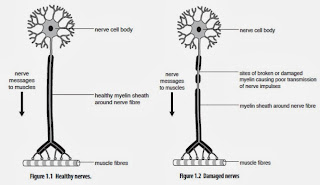A. Definition of Multiple Sclerosis
What is Multiple Sclerosis? Multiple sclerosis is an inflammation that occurs in the brain and spinal cord that attacks the white matter area and is a major cause of disability in young adults. Can be caused by many factors, especially the autoimmune process.
Focal lymphocytic infiltration or T cells migrate out of the lymph nodes into the circulation, penetrating (blood brain barrier) continuously to the location and an attack on the myelin antigens in the central nervous system such as that commonly occurs in every infection. This can result in inflammation, damage to myelin (demyelination), neuroaxonal injury, astrogliosis, and degenerative processes. As a result of demyelination, neurons become less efficient in the action potential. Transmission of impulses conveyed by neurons that demyelinated would be bad. Due to 'leak' the impulse, occurs weakness and difficulty in controlling certain muscles or sensory activity in various parts of the body.
If patient's brain with Multiple Sclerosis were cut, it would seem that induratif patches in multiple white matter which makes named multiple sclerosis. The lesions are generally located in the periventricular, corpus callosum, optic nerve, and spinal cord. Moreover, it can be found in the brainstem and cerebellum. Microscopically, the lesion showed myelin destruction, partial or total. Also found perivascular infiltration of monocytes, lymphocytes and macrophages, whereas astrocytes and oligodendrocytes in the late phase. In a relatively acellular lesions, generally intact axons and remyelination occurs, whereas the infiltrative lesions, axonal degeneration occurs.
 |
| Different between Healthy nerves and Multiple Sclerosis nerves |
B. Etiology of Multiple Sclerosis
What are causes of Multiple Sclerosis? The etiology of these disorders remains unclear. There are several important mechanisms underlying causes patches of Multiple Sclerosis ( MS ) is an autoimmune, infectious, and hereditary. Although conclusive evidence is lacking, dietary factors and toxins exposure has been reported to contribute as well. These mechanisms are not mutually exclusive but rather a combination of various factors .
What are causes of Multiple Sclerosis? The etiology of these disorders remains unclear. There are several important mechanisms underlying causes patches of Multiple Sclerosis ( MS ) is an autoimmune, infectious, and hereditary. Although conclusive evidence is lacking, dietary factors and toxins exposure has been reported to contribute as well. These mechanisms are not mutually exclusive but rather a combination of various factors .
Autoimmune mechanism is thought to occur through a decrease in the activity of T- suppressor lymphocytes in the circulation of patients with MS and the presence of molecular mimicry between antigens and MBP ( myelin basic protein ) that activates T cell clones specific for MBP ( MBP -specific T - cell clone ). T4 become autoreactive lymphocytes on exposure to foreign antigens are structural similar to the MBP. Not just some viral and bacterial peptides that have structural similarities only with MBP, but some of these microorganisms can activate MBP - specific T - cell clones in patients with MS.
Some viral infections are known to cause demyelination in humans including progressive multifocal leukoencephalopathy caused by JC papilloma virus, subacute sclerosing panencephalitis measles virus. In MS early serological studies difficult to interpret. However, many MS patients are elevation CSF titers against measles and herpes simplex virus (HSV), but this is also not specific.
C. Multiple Seclerosis Classification
Based on clinical differences and symptoms , there are several types of Multiple Seclerosis :
Based on clinical differences and symptoms , there are several types of Multiple Seclerosis :
1 . Relapsing - remitting Multiple Seclerosis.
Many cases are generally originated from Seclerosis Multiple forms which are intermittent symptoms, especially in young adults. A classic clinical course of multiple sclerosis where there are relapses and remission phases. Symptoms only worsened when the attacks although it can develop into secondary progressive multiple sclerosis.
2 . Chronic Progressive Multiple Seclerosis.
Symptoms gradually worsen after first-episode schizophrenia and an increase in the disability continues without remission phase interspersed at all. Often involves a decrease in the body's motor movements, or the performance of sensory (mainly visual).
3 . Benign Multiple Seclerosis.
Symptoms are relatively small, growth is so slow that almost clinically invisible, or there is a bit of an attack over a long period of time usually 15 years after diagnosis. There is evidence to suggest that Seclerosis Multiple trips may initially benign . However, evidence from long-term studies mentioned Seclerosis Multiple benign cases that eventually lead to significant symptoms and disability, although this may not occur for 20 or 30 years after diagnosis.
4 . Secondary Progressive Multiple Seclerosis.
Relapsing - remitting Multiple Seclerosis can be transformed into the secondary progressive form of Multiple Seclerosis which began a decline in the frequency of remission is relatively stable but quite rare .
Source
1. Pict: https://neurowiki2012.wikispaces.com/Stem+Cell+therapy+for+Multiple+Sclerosis
